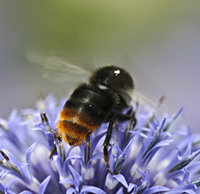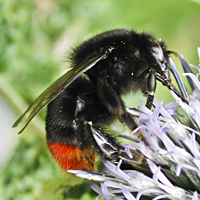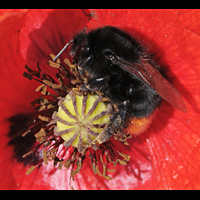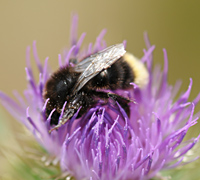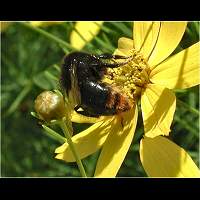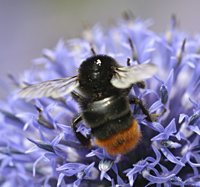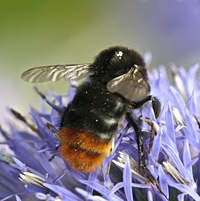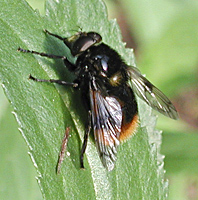[All pictures of garden wildlife on this page are thumbnails. Click on any thumbnail for a large format to be displayed.]
Red-tailed Bumblebee or Stone Bumblebee or Large Red Bumblebee
(Bombus lapidarius)
The Red-tailed Bumblebee is a common visitor in many gardens. In our garden however it is rather rare and the first one wasn't seen until August 2002. This is a huge species (about the same size as the Earth Bumblebee and the Garden Bumblebee). In the vicinity of the nest the Red-tailed Bumblebee is more agressive than most other species of bumblebee and it is quite happy to sting any intruder. This species is entirely black, except for the red tail. The intensity of this red colour varies from striking deep red through orange to even white depending on how much it has been exposed to sun and rain. This bumblebee cannot be not easily mixed up with other species and because a few look-a-likes around are really rare in common gardens. In some cases the queen has a small white-yellow band on the front end of the thorax. Males, workers and queens do not differ much from one another, which is rather unbique among bumblebees. The hoverfly Volucella bombylans, var. bombylans looks like this bumblebee very much, as is shown below! Scientifically this bumblebee used to be called Pyrobombus lapidarius.
The Red-tailed Bumblebee makes its appearance quite late, usually in April. In exceptionally warm springs it maight appear a bit earlier, during the second half of March. The colony remains rather small and rarely ever comprises of more than 300 individuals. Normally the nest is built underground, for instance in the remnants of a mice nest. Sometimes the nests are found in openings in walls, birds nests or nesting boxes. Bombus lapidarius is a common species all over Europe, including the British Isles. The animal easily adepts itself to man made changes in the natural environment. It will adopt even small beds of flowers in the middle of big cities and welcomes parks, gardens, and the fringes of woodlands, even though it will never live within forests. The Red-tailed Bumblebee visits well over 200 species of flowers, including many exotic garden species. Nevertheless, it is not used in agriculture because of its unpleasant character and eagerness to sting.
The Red-tailed Bumblebee is also known as Stone Bumblebee or Large Red Bumblebee. Scientifically it was known as Pyrobombus lapidarius in the past.
The Red-tailed Bumblebee makes its appearance quite late, usually in April. In exceptionally warm springs it maight appear a bit earlier, during the second half of March. The colony remains rather small and rarely ever comprises of more than 300 individuals. Normally the nest is built underground, for instance in the remnants of a mice nest. Sometimes the nests are found in openings in walls, birds nests or nesting boxes. Bombus lapidarius is a common species all over Europe, including the British Isles. The animal easily adepts itself to man made changes in the natural environment. It will adopt even small beds of flowers in the middle of big cities and welcomes parks, gardens, and the fringes of woodlands, even though it will never live within forests. The Red-tailed Bumblebee visits well over 200 species of flowers, including many exotic garden species. Nevertheless, it is not used in agriculture because of its unpleasant character and eagerness to sting.
The Red-tailed Bumblebee is also known as Stone Bumblebee or Large Red Bumblebee. Scientifically it was known as Pyrobombus lapidarius in the past.

© Copyright 1998-2024 gardensafari.net (Hania Berdys)

 English / engels
English / engels  Dutch / nederlands
Dutch / nederlands